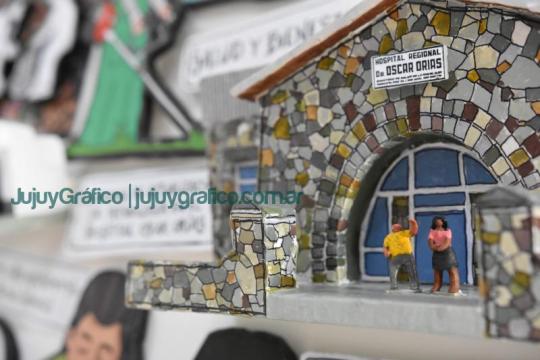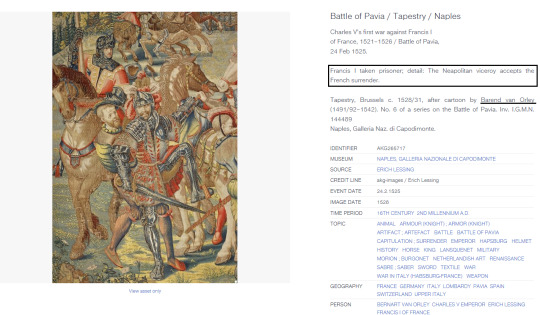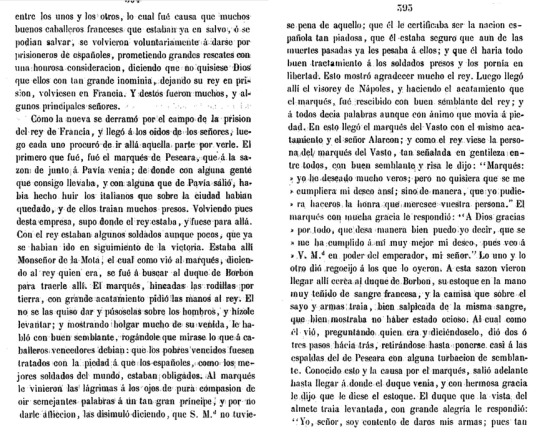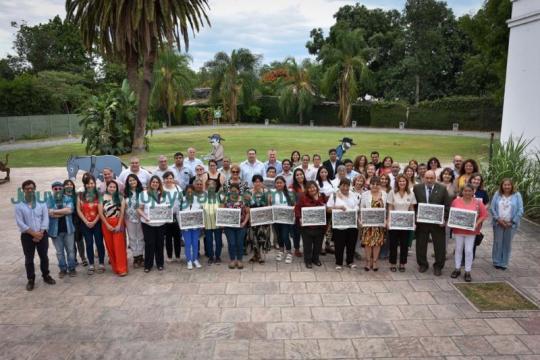#Fernando Ferramosca
Text
Ledesma inauguró un mural que homenajea el trabajo junto a la comunidad
#Jujuy #Cultura #RSE | #Ledesma inauguró un #mural que homenajea el trabajo junto a la comunidad
Ledesma inauguró en su Centro de Visitantes en Libertador General San Martín un mural del arquitecto y artista plástico Fernando Ferramosca, cuyo contenido refiere el vínculo y trabajo que la compañía mantiene junto a la comunidad que la rodea.
Ferramosca fue invitado en diciembre pasado a conocer el complejo agroindustrial de Ledesma en Libertador General San Martín y también las instituciones…

View On WordPress
#Centro de Visitantes#El Piquete#Fernando Ferramosca#Ledesma#Libertador General San Martín#mural#San Francisco#San Salvador de Jujuy#Santa Bárbara#Valle Grande
0 notes
Text
Who The Fuck Is This?

(If you want to skip the BS, my best guess as to his identity is at the bottom)
While reading The Renaissance At War by Thomas Arnold, I came across a nice piece of artwork depicting part of The Battle of Pavia (1525). Image attribution seems to suggest it came from AKG Endpaper.
Sounds good, let’s have a gander.

Found this after navigating a shit load of redirects. The description is a bit misleading, as one may be led to believe this armored gentleman to be Francis I. The full image (which is apparently part of a multi-piece tapestry set by an artist named Bernard Van Orley) is actually included in Arnold’s book and identifies another as the French king. It’s possible that the individual above (henceforth known as WHOAREYOU) is someone else. Perhaps the ‘Neapolitan Viceroy’? Okay, so who the fuck is that?
Here is another picture from the book, which is a snapshot of the battle. The style reminds me of some of Martin Dougherty’s stuff, which is pretty cool. (Also, please excuse the shitty camera quality)

It’s difficult to see, but all named figures are supposed to be shown in blue, with the exception of ‘De Vasto’ in the middle, who is part of the Imperial forces in red. It seems as though this fellow must be pretty important to be singled out this way.
I’ve another book here, Paolo Giovio by T.C. Price Zimmermann which suggests that De Vasto is a man by the name of Alfonso (whose wife spent time with the eponymous Giovio). Alfonso is related to Francisco Fernando, Marquis of Pescara. This is relevant, because in Michael Edward Mallett and Christine Shaw’s book, The Italian Wars, 1494–1559: War, State and Society in Early Modern Europe, the following is given regarding the Battle of Pavia:
“This has often been presented as a battle commanded by Pescara, and
much of the credit for the victory has been given to his planning and
his deployment of the arquebusiers. He claimed it was his idea to attack
through the park. The contemporary historian Giovio said that Pescara
had been given overall command of the army but imperial sources made
no mention of this, although Pescara was singled out for praise for his
valour and energy. In the field, Bourbon and Lannoy had taken the most
honourable positions in command of the cavalry.“ (Mallett and Shaw, 152)
Note that line about Giovio. Zimmermann says something relevant about this:
“Giovio personally interviewed many of the surviving participants, including
Francis I, but achieved vividness and clarity by holding for the most
part to Pescara’s contemporary account of the battle to Charles V.“ (Zimmermann, 74)
There’s an annotation attached to this:
“On the interviews with Francis I (at Marseilles in 1533 and again at Nice in 1538) see Vita del Pescara (1931), 435. Sir Charles Oman called Giovio’s account of Pavia the most detailed (The Art of War in the Sixteenth Century, 186–206). For Pescara’s letter to Charles V see M. F. Navarrete, M. Salvá, and P. S. deBaranda, eds., Collección de documentos inéditos para la historia España 38 (1861), 408–12?
It’s possible that Pescara held principle command. This link I found (couldn’t find the book it’s based off of, but I like De Re Militari, so I’m willing to believe them) seems to corroborate this somewhat, as it calls Pescara the ‘chief of the emperor's host’
(http://www.deremilitari.org/RESOURCES/SOURCES/pavia.htm
Last part of the annotation:
“For eyewitness sources Giovio also had del Vasto and Giambattista Castaldo, who took Francis I prisoner.”
So, all this to say that De Vasto -might- be WHOAREYOU, while Pescara is running overall command...
...until you get to this:
“Although the d’Avalos were in origin a Spanish family, Pescara himself
had been born in Italy, and his title was a Neapolitan one.” (Zimmermann, 76)
Great, does that mean that Pescara is the Neapolitan viceroy (and therefore WHOAREYOU) or is this ‘title’ not necessarily related.
Moreover, there’s also the idea that just because AKG says that the viceroy accepted the surrender, that does not mean it has any bearing to the actual scene of what was going on with Francis. It may have been a broad and not strictly related summary. Hell, who knows what kind of biases and reformats went into the original accounts to begin with. This is starting to feel like an Ouroboros of bullshit.
“The large number of conflicting and often self-serving contemporary
accounts makes the battle of Pavia difficult to reconstruct in congruent
detail.“ (Zimmermann, 84)
You’re fucking telling me.
Let’s take a break and see if Wikipedia is going to be of any help in the matter.

Where the hell did all these people come from?
Okay, we know some of these people already (mostly Fernando and Alfonso). I took another crappy photo of Arnold’s book which elaborates a bit on Bourbon.

I already mentioned Bourbon in the quote about the cavalry, along with Lannoy. More about the latter is contained here:
“The imperial army was strengthened by the arrival in late December of
the new viceroy of Naples, Charles de Lannoy, and Pescara, bringing troops
from Naples.” (Mallett and Shaw, 147)
Aha, ‘Viceroy of Naples’. So perhaps Lannoy is our mysterious WHOAREYOU (let’s just assume the AKG image is portraying the viceroy, for my own sanity)
What does his wiki page say?

We’re off to a good start.
Fortunately, we actually do have some sources. Here’s a bit in Correspondence of the Emperor Charles V. and his ambassadors at the courts of England and France : from the original letters in the imperial family archives at Vienna; with a connecting narrative and biographical notices of the Emperor and of some of the most distinguished officers of his army and household; together with the Emperor's itinerary from 1519-1551, the title of which is going to be longer than the actual content:
“CHARLES DE LANNOY VICEROY OF NAPLES TO THE EMPEROR Villa Franca 10th of June 1525? (118)
I think we can do a little better than that.
There’s a reference to this in La corte de Carlos V by José Martínez Millán. I found an archive of it (https://repositorio.uam.es/xmlui/handle/10486/742) so let’s check it out.


Nice, it’s partitioned into a bunch of different pdfs, that’s just fucking wonderful.
The part we care about comes from CAPITULO6, pages 233-234 :
“Por su parte, Charles de Lannoy enviado a Ñapóles, había dejado su lugar al frente de la caballeriza a Cesare Ferramosca.”
Yeah, I don’t really speak Spanish. Let’s just run it through an online translator:
“For his part, Charles de Lannoy sent to Naples, had left his place in front of the stable to Cesare Ferramosca.”
Sent to Naples, eh? I’m pretty sure we can make an argument that Lannoy is indeed the viceroy we’re looking for.
The wiki page of the battle proper also has this to say: “The exact nature of Francis's surrender—in particular, who exactly had taken him prisoner—is uncertain, with a variety of candidates ranging from Alonso Pita da Veiga, Juan de Urbieta and Diego Dávila to Lannoy himself being put forward by various historians.“
WHOAREYOU could be any of these people as well, though Lannoy so far has the best argument for it (Again, for my sanity, let’s just assume the artwork is depicting the viceroy). Unrelatedly, Diego there doesn’t even have a wikipedia page. Here’s a reference to him in Colección de documentos inéditos para la historia de España, Volume 38, page 391, which talks a bit about events that took place after Francis was unhorsed:

The text becomes corrupted when I try to copy this, but the rough translation looks like:
“Then he came to where the king was another Darmas man from Granada called Diego de Avila, who, as the king saw on the ground with such trappings, went to him to surrender the king told him who he was and that he was surrendered to the emperor and asking him If he had given Gaje M, he told him that Diego de Avil was not asked and he gave him the rapier that he had brought with him, and a mitten and decked Diego de Avila worked to get him under the horse And in this there came another man from Galicia. called Pita which helped him to raise and took to the king the badge that of Saut Miguel to the neck it brought in a chain that is the order of the cavalry of France and tie it as those of the emperor the Tuson For this the king offered him to give him six mili duked but he did not want them but bring it to the emperor While the King of France was standing, some arcabuceros soldiers came to the party, who, not conning him, wanted to kill him because they did not believe the They told him that he was the king and without them they could not save his life if Monsignor de la Mota, a great and great friend of the Duke of Borbon, who had walked with him and disarmed him, had not come to that place. saw the contest that there they had...“
More importantly, on page 394 and 395, mention is made of a number of key imperial figures and their interaction with Francis:

It names the Marquis of Pescara, Monsignor de la Mota, the Duke of Bourbon, the Marquis of Vasto, and the Viceroy of Naples.
Now, since the text is FUBAR, it’s difficult for me to pinpoint when this event took place. It’s possible that this took place far later than the initial capture of Francis. That said, it does at least support the idea that Lannoy, at some point, did have an interaction with the king.
Here is another excerpt from page 411-412. If I’m understanding this correctly, this one comes to us courtesy of Pescara himself:

He seems to be talking about specific maneuvers. Of worth to us is the reference to the ‘Viceroy’ and his participation.
The wiki page makes a fuckton of references to Angus Konstam’s Pavia 1525: The Climax of the Italian Wars. Let’s take a quick look.
Of immediate note is this image (as illustrated by Graham Turner):

Aha MK2. This looks familiar. It seems that Konstam and Arnold may have been working off the same sources (probably Oman as the main one, or whatever he was working off of). This would explain why the initial image only contained De Vasto’s name. Here, we see one of the earlier manuevers where De Vasto played a key part in securing Castello Mirabello with his detachment of arquebusiers. Since Arnold’s book was probably providing a broader overview, it only used one moment from the battle.
Later on, we see this unfold:

Bourbon, Pescara, and Georg von Frundsberg (and De Vasto, though he’s not explicitly named) seem to have caught Francis in a bit of a trap. More important than that, however, it that we actually have a map that names all of them. Note Frundsberg’s position. The text states that he was engaging the ‘Black Band’.
The book also goes on to say this:
“In the middle of this carnage the king apparently fought well, until his horse was brought down and he was surrounded by arquebusiers armed with daggers. Lannoy, who by then had returned to the scene, is reputed to have ridden into the fray and rescued the king, defending him at sword point from his own men. French sources disagree, and a number of people claimed the glory of capturing the king. Whatever the situation, Lannoy was on hand to extricate the king and accompany him to the rear, escorted by files of Neapolitan arquebusiers (probably part of De Vasto’s force).” (Konstam, 73)
Even though there’s some dispute here, it’s likely that Lannoy was at least somewhat near the proceedings.
Thus far, I’ve been avoiding the most obvious piece of this puzzle, which is the tapestry itself. After all, despite what may or may not have happened, in some ways, the tapestry tells its own story, as Van Orley may have had specific people in mind when he created it. Or he may have even elevated certain key figures above others, depending on his own preferences.
RIHA journal gives a superb treatment of the tapestry and it’s associated events here: (https://www.riha-journal.org/articles/2014/2014-oct-dec/paredes-battle-of-pavia)
Down at the bottom, we have this tidbit:
“Most of these commanders are portrayed and identified by inscriptions in the tapestries “
I don’t have these inscriptions, but Thomas Campbell talks a bit about the art in Tapestry and the Renaissance Art and Magnificence
“Description of the Drawing: The preparatory drawing for the Surrender of King Francis...illustrates the key episode in the battle and closely anticipates the structure and appearance of the tapestry (fig. 147). The strongly centralized composition, with the three horsemen looking directly out of the scene, is unique within the series, indicating that it was probably the centerpiece of the whole set. Many of the figures are portraits and some can be identified from the woven inscriptions on the tapestry itself. To the left, King Francis I is helped from his dying horse by Count Nicolas von Salm, commander of the German cavalry. He is assisted by La Motte de Noyers, captain of the Bourbon cavalry, who fought on the imperial side, and the count of Monmartin. Farther to the left, under the imperial banner...the imperial commander Charles de Lannoy climbs from his horse” (Campbell, 322)
There we have it.
Given how I cannot seem to locate the inscriptions myself, I’m willing to accept the idea that Lannoy is indeed the one we’re looking for. Later on, Campbell adds this:
“Artist: The tapestries were designed by Bernaert van Orley, court painter to Margaret of Austria and later to Mary of Hungary” (Campbell, 328)
If Van Orley is in the employ of the Hapsburg house, I think it’s safe to assume that, barring some strange circumstances I’m not aware of, he wouldn’t have too much reason to intentionally change events as they had unfolded.
I think by this point, we can make a fairly strong argument that Lannoy was the Neapolitan viceroy, was involved in the battle, and is the figure depicted in Van Orley’s tapestry, meaning he is WHOAREYOU. I’d like to cross reference Oman’s book and also check on Frundberg’s accounts to be safe, which I might do if I revisit this post again.
tl;dr I’m pretty sure it’s Charles de Lannoy
(As an interesting tidbit, Campbell mentions that the tapestry set eventually found its way into Pescara’s possesion, which is a pleasant way of tying everything back to where it started, from my point of view at least)
2 notes
·
View notes
Text
La empresa Ledesma despidió el 2022 de trabajo junto a la comunidad
#Jujuy #RSE #Empresariales #Institucionales | La empresa #Ledesma despidió el 2022 de trabajo junto a la comunidad
La empresa Ledesma agasajó a la comunidad de las Yungas con el objetivo de celebrar el acompañamiento y los logros alcanzados en 2022. La actividad se desarrolló en el Centro de Visitantes Ledesma y contó con la participación de referentes de distintas instituciones públicas y privadas.
La empresa Ledesma y la comunidad
En la oportunidad, se inauguró un mural referido al vínculo de la compañía…

View On WordPress
#Centro de Visitantes Ledesma#Diego Pons#El Piquete#Fernando Ferramosca#Ledesma#Ledesma S.A.A. I.#Ledesma SAAI#Leonor Calvó#San Francisco#San Salvador de Jujuy#Santa Bárbara#UNJu#Valle Grande#Vicente Amadeo#Yungas
0 notes